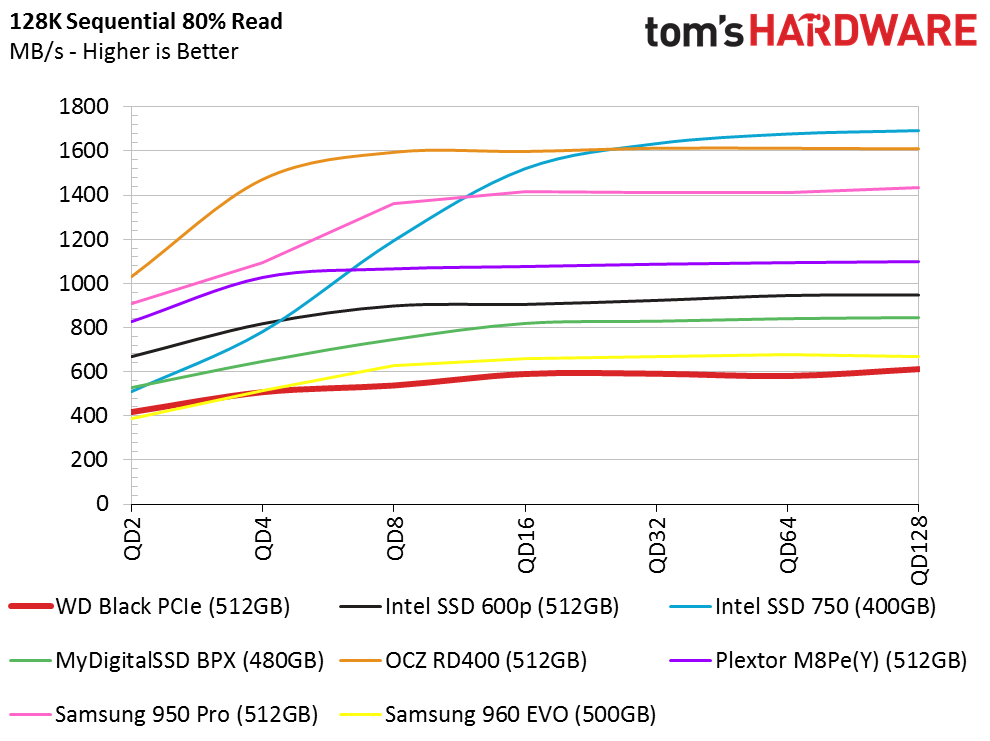WD Black PCIe 512GB SSD Review
Why you can trust Tom's Hardware
512GB Performance Testing
Comparison Products
Our usual list of NVMe products makes up the comparison test group. There are so many 512GB-class NVMe products that we can no longer fit all of them in the charts. That's good for consumers as it increases the supply, but at the same time, there is a big demand for low-cost models like the Western Digital Black PCIe.
The Intel 600p resides at the lower end of the price spectrum, and it may be the most popular retail NVMe SSD due to its low price. The MyDigitalSSD BPX costs a little more, but for the extra up-charge, you get SanDisk 15nm MLC NAND and a substantial performance increase. These two products compete directly with the Black PCIe.
The flash shortage has prices rapidly fluctuating as warehouses struggle to balance supply and demand. Most of the newer products have seen price increases since launch, so many retail for more than the original MSRP. Older products like the Intel SSD 750 have seen price cuts in an effort to retain relevance. This is just part of the natural ebb and flow of selling products in a flash market turned upside down.
For the most part, there are two price categories for the products in our tests. The low-cost group starts at just $165.99 (Intel 600p) and grows to $250 (Samsung 960 EVO 500GB). All of the products in this price range, including the Western Digital Black PCIe, utilize 3-bit per cell (TLC) NAND. The MyDigitalSSD BPX 480GB ($179.99) is the only exception, and it's also the overall value leader in the low-cost NVMe space.
The other MLC NAND products make up the upper tier with prices starting in the low $300 range and peaking in the low $400s. When we combine the two categories, we see a very wide price range that starts at $165 and ends in the low $400s.
Sequential Read Performance
To read about our storage tests in-depth, please check out How We Test HDDs And SSDs. We cover four-corner testing on page six of our How We Test guide.


The NVMe protocol over PCI Express opened the flash performance floodgates. The SATA interface, which the industry designed for spinning disks, no longer limits the storage media. Some of the products provide nearly a 5x increase in sequential read performance compared to SATA. The new WD Black PCIe SSD manages 930 MB/s at QD2 on its way to a reaching peak speed of 1,500 MB/s with a single worker. The Black's sequential read performance is slightly higher than the Intel 600p but less than the MyDigitalSSD BPX.
Get Tom's Hardware's best news and in-depth reviews, straight to your inbox.
Sequential Write Performance
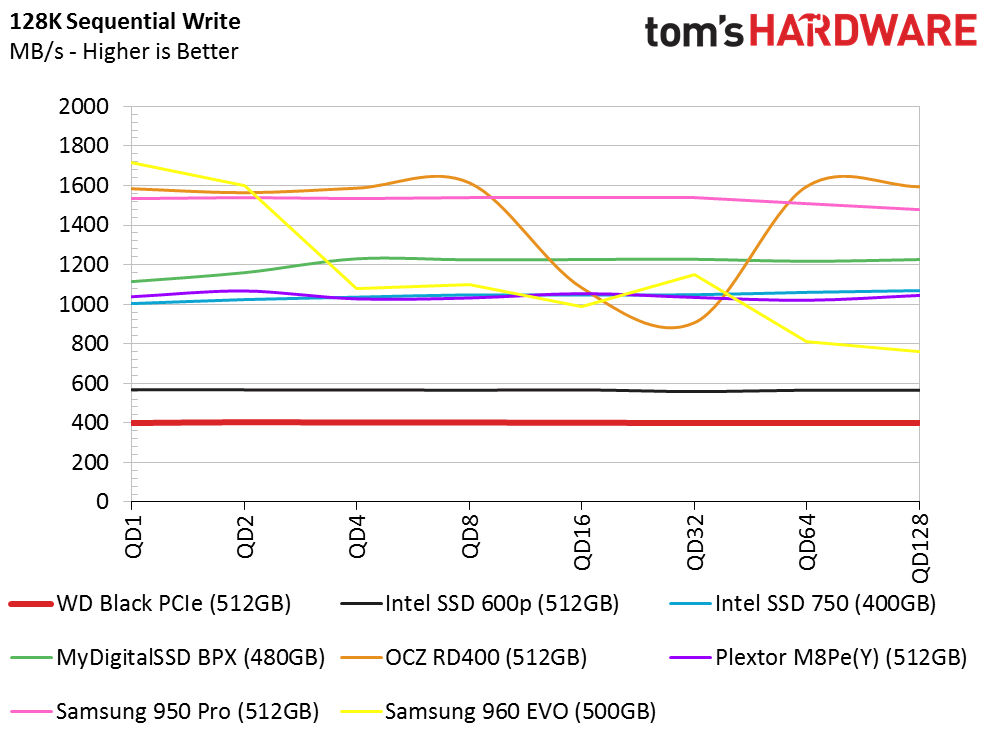

The sequential write test reveals the distinct performance bands for the different products. These tiers make it easy to spot the TLC-based products, and the 960 EVO suffers degraded performance at higher queue depths. The Black PCIe offers the lowest sequential write performance, but what we see here isn't what you may see at home.
Sustained Write Performance
We see the same 400 MB/s write speed in this test, but the small SLC cache gives you 800 MB/s. At that speed, the cache is only effective for a moment before the SSD downshifts to native TLC performance. The native TLC write performance with only two packages (with sixteen NAND die each) is better than we expected, but it isn't in the same range as the other NVMe products on the market.
Random Read Performance



The Western Digital Black PCIe broke 10,000 random read IOPS, which is an important milestone for SanDisk -- it's the company's first consumer SSD to accomplish the feat. The drive scales well as the queue depth increases, too.
Random Write Performance
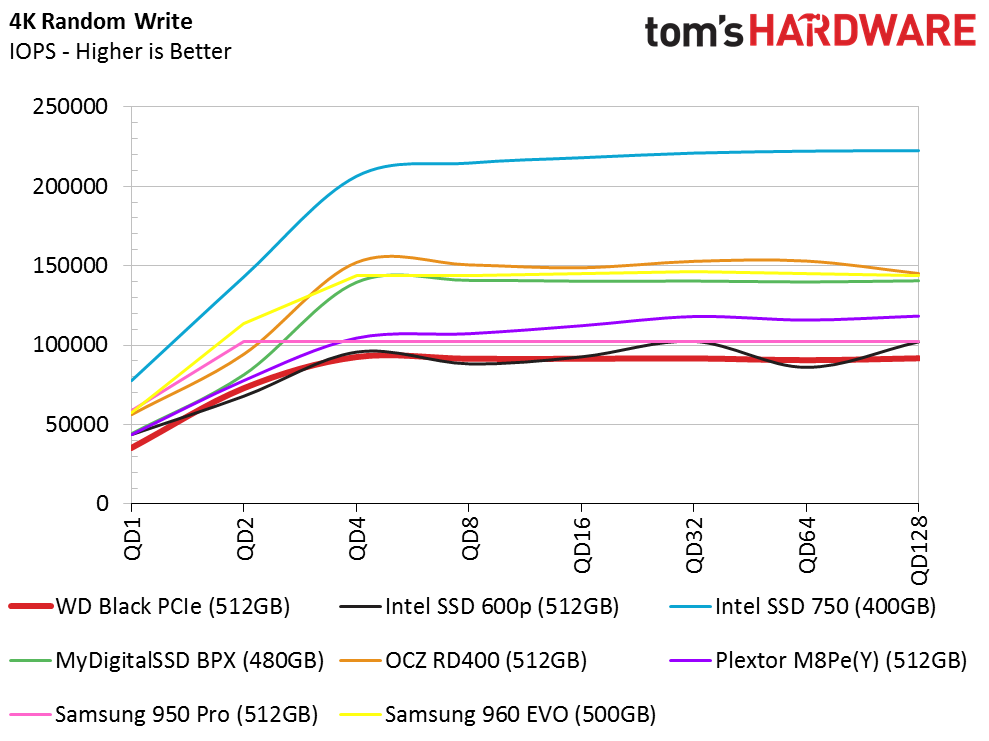


The Black's low-QD random write performance is also good for a low-cost SSD. If you managed to push the Black PCIe to QD4, the drive would really pick up the pace. Even with heavy multitasking, I don't see many users breaking 100,000 IOPS, but this drive has the capability to chew through that workload with ease thanks to the SLC buffer.
80 Percent Sequential Mixed Workload
We describe our mixed workload testing in detail here and describe our steady state tests here.
This test was very interesting. The Plextor M8Pe uses the same Marvell "Eldora" controller as the Black PCIe, with the only difference being MLC vs. TLC NAND. The Plextor drive performs really well in the sequential mixed workload test, but the Black PCIe rides the slow rail and provides the lowest performance. The Intel 600p outshines the Black PCIe, too.
80 Percent Random Mixed Workload
The Black PCIe also encounters difficulty during the mixed random workload. This tendency becomes evident later in the review when we test actual software running on the drive.
Sequential Steady-State



Just because an SSD is NVMe doesn't mean it’s capable of tackling workstation-level tasks at high speeds. The Black PCIe is faster than low-cost TLC SATA SSDs during heavy sequential workloads, but it trails all of the other aftermarket NVMe SSDs.
Random Steady-State
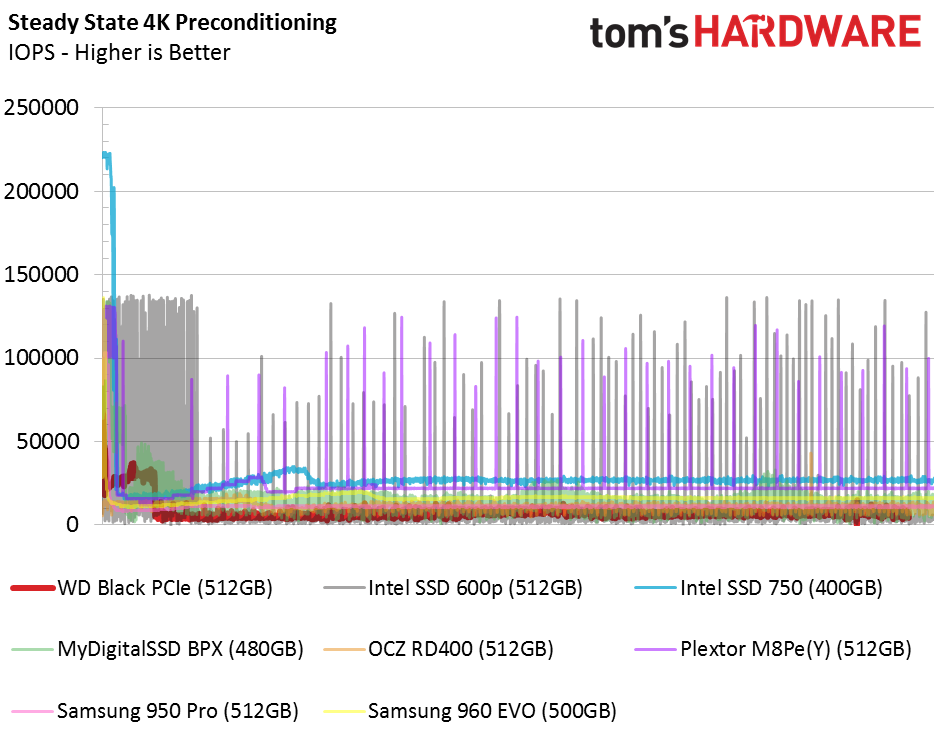

The Black PCIe doesn't look like a viable product for consumer RAID arrays. The 4KB write performance in steady-state is more consistent than some of the other products, but the write speed is lower and less consistent than we like to see.
PCMark 8 Real-World Software Performance
For details on our real-world software performance testing, please click here.

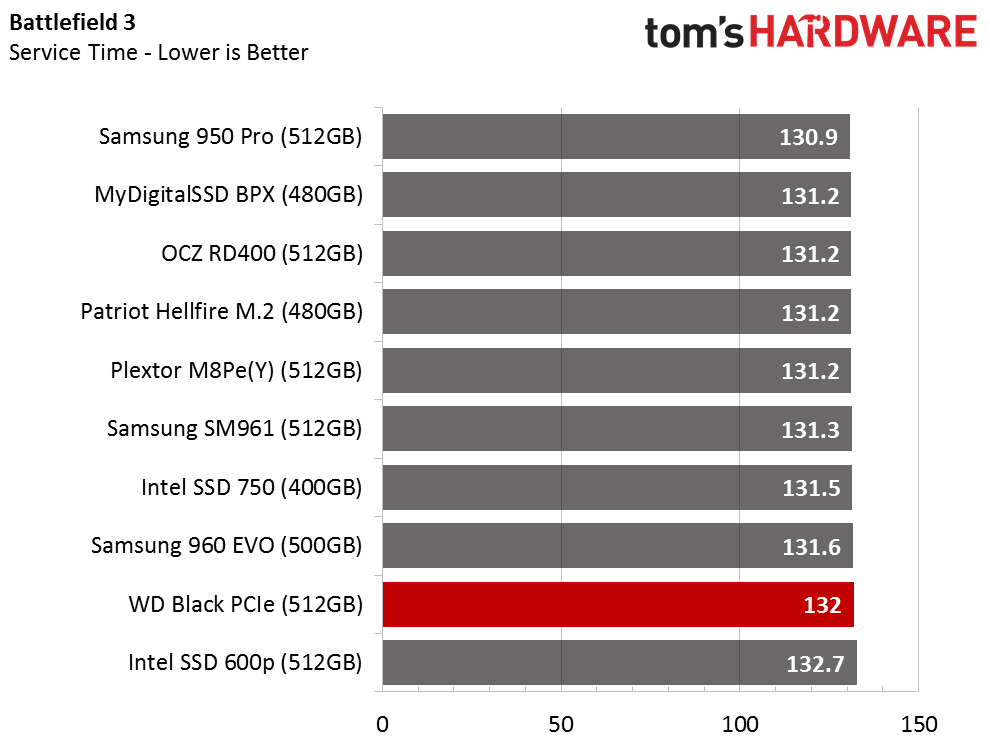


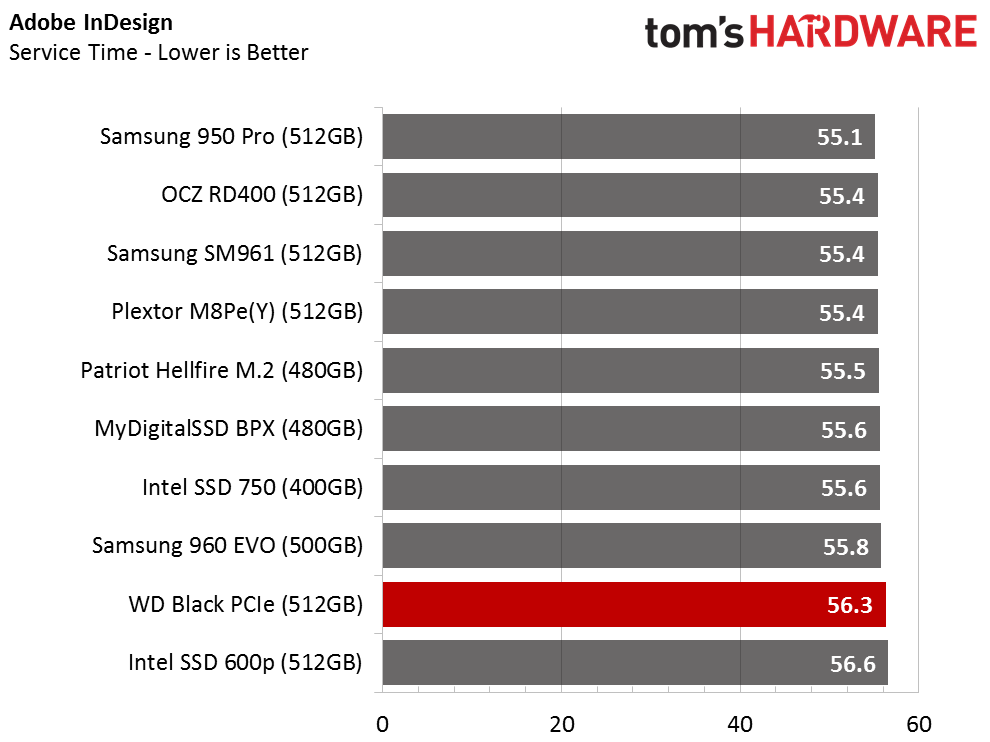





The mixed random workload test suggested we would see low performance in real-world applications. Here we see those results inserting themselves into the mix. The Black PCIe performed well in the lightest workloads, but many of the more complicated tasks show the drive at the tail end of the charts.
Application Storage Bandwidth
The Black PCIe is faster than the Intel 600p, and we consider its performance to be superior to Intel's entry-level NVMe product. You should also consider the Black's endurance and other aspects, like the use of planar NAND.
PCMark 8 Advanced Workload Performance
To learn how we test advanced workload performance, please click here.



The WD Black PCIe really only competes with the two other low-cost NVMe solutions. The WD Black PCIe is faster than the low-cost 600p, and that shows in the PCMark 8 Extended Test. The MyDigitalSSD BPX 480GB with MLC NAND is the other contender, and this chart series shows exactly where the Black PCIe stands against that drive.
The BPX isn't available in all markets, and WD's global presence will push the Black PCIe to the forefront of low-cost NVMe products in several regions.
Total Service Time



The service time test reveals how much better the Black PCIe is compared to the Intel 600p. IMFT's flash has some issues that we've seen on both the Intel and Micron side. The 384Gbit die has a density advantage, but it also has latency issues that we've yet to see tamed except in Intel's 18-channel enterprise model and Micron's enterprise drive, which comes with a massive 70% overprovisioning.
Western Digital and partner Toshiba have yet to release a consumer SSD with 3D NAND, but it's shipping in the latest iPhone (and possibly other products). We have to wonder if the Flash Forward 3D NAND has latency issues, or if Apple is just taking everything the factory can produce. Either way, Toshiba's 15nm planar TLC has some advantages over IMFT's 3D TLC.
Disk Busy Time
The disk busy time test also shows a clear distinction between the Intel and WD NVMe SSDs.
SYSmark 2014 SE Responsiveness Test

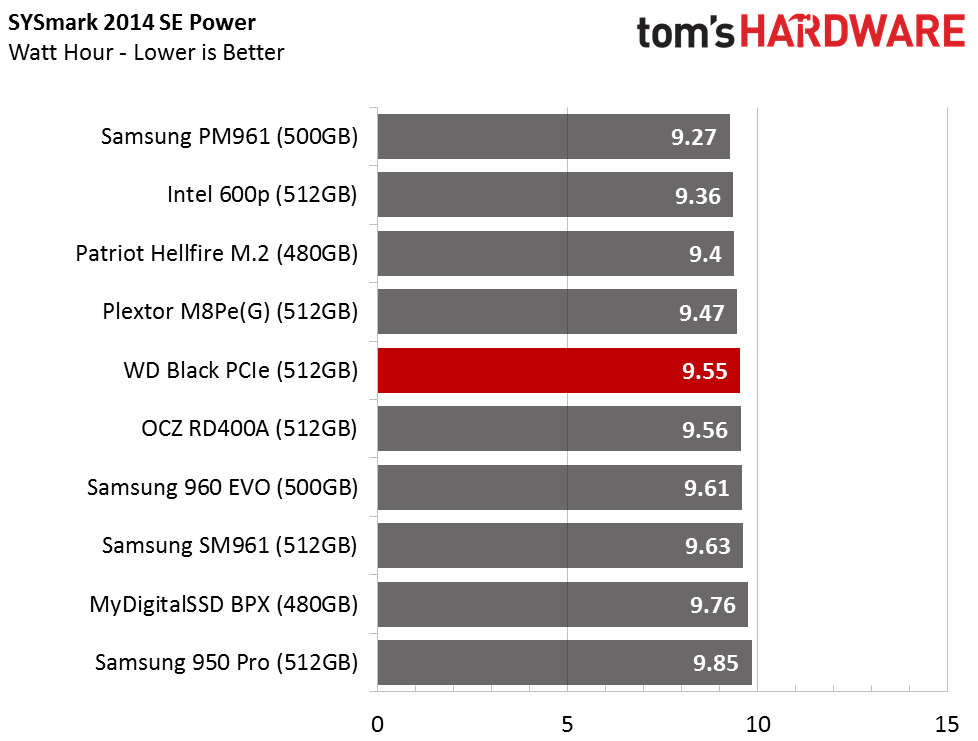
We still need to write our detailed look at the BAPCo SYSmark 2014 SE test, but this can serve as a quick introduction. The Responsiveness Test uses a weighted score with a Samsung TLC SSD as the reference. The Samsung drive's reference responsiveness score is 1000, and the other products show either better or worse performance. We would have rather had the performance score based on a consumer SATA HDD rather than a SATA SSD, but Lenovo shipped the reference system to BAPCo with the OEM Samsung drive installed.
With a score of just 1002, or only slightly more responsive than the Samsung OEM SATA SSD, the WD Black PCIe is only a slight upgrade over the OEM drive and surprisingly scores lower than some high-performance SATA drives.
MobileMark 2014 v. 1.5 Notebook Battery Life

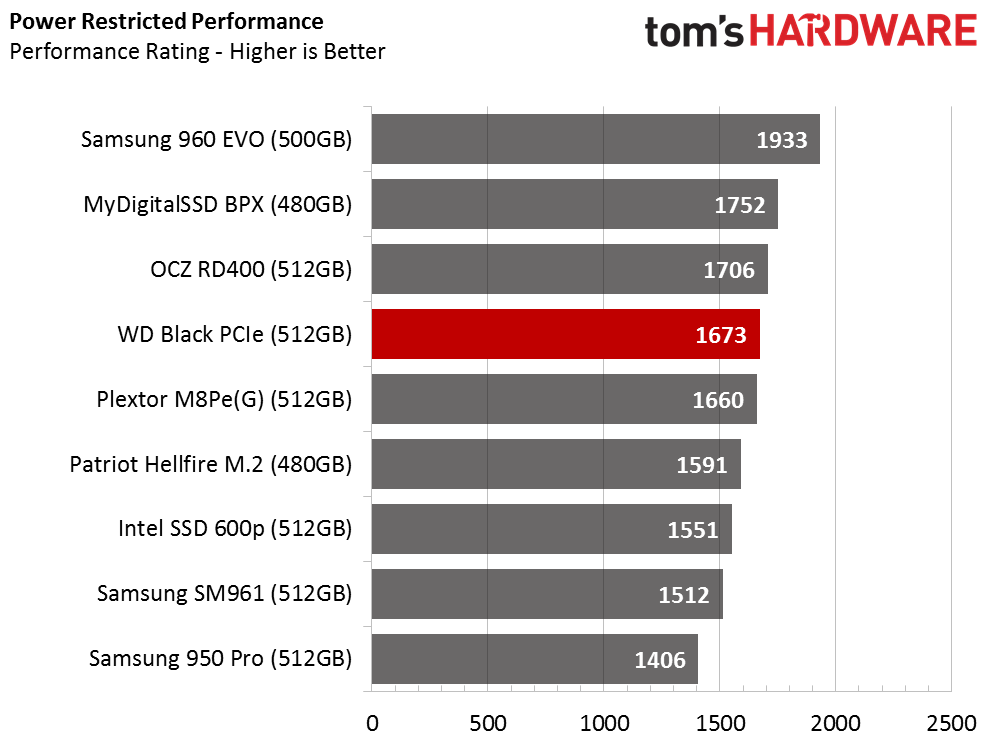
The Black PCIe uses the Microsoft NVMe driver, so we didn't run into any premature battery draining issues like the Samsung NVMe SSDs. The Black PCIe scored 352 minutes with MobileMark 2014 v. 1.5 in our Lenovo Y700-17. This drive is the best low-cost NVMe solution available for notebook users seeking long notebook battery life.

Chris Ramseyer was a senior contributing editor for Tom's Hardware. He tested and reviewed consumer storage.
-
lun471k I was all hyped up when I saw the article title. Each line I read and graph shown just killed the feeling. Looks like WD's far behind everyone else. I was hoping they'd at least be in the mid range, especially considering the branding of the black series.Reply -
sillynilly Agree LUN - I was a WD fanboy in the HDD days and wanted to see similar performance from the black lineup. Looks like crap on a cracker instead. Too bad.Reply -
velocityg4 Looking at current pricing. There is nothing remarkable about it. It is priced around the similar performing Intel 600p and MyDigitalSSD BPX. Looking at real world uses. For the average user, gamer, workstation user, &c you won't notice the difference. So get whichever NVMe option is the cheapest.Reply
If you are running a server, multiple VMs or some special workstation functions. Then performance will matter. -
ubercake Seems like getting SanDisk on board would yield more competitive results. Maybe WD still insists on being the boss even though they are late to the game?Reply -
Stevemeister "Seems like getting SanDisk on board would yield more competitive results". This reminds me of when Daimler-Benz hitched itself to Chrysler . . . it didn't raise the standards at Chrysler rather it started to sink DB. This looks like another case of a smaller high performance brand being dragged down into mediocrity (or worse) by a much larger but technically obsolete Behemoth.Reply -
gasaraki I got the MyDigitalSSD BPX and it's really fast in everyday use. Why get this when the BPX is cheaper, faster and has better endurance?Reply -
takeshi7 In the Random Write Performance chart you seem to have switched the MyDigitalSSD BPX with the WD Black. In the first graph it shows the BPX getting around 150K IOPS and the Black ~98K IOPS, but the second graph shows the BPX with ~98K IOPS and the Black with ~150K IOPS.Reply -
hpram99 Looking at the chart, that's about 10ms at 800MB/s that means the cache is 8MBReply
Really? This is false advertising that the drive is 800MB/s for 0.001% of the drive




